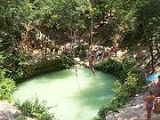
Sinkhole
Overview
Cenote
A cenote is a deep natural pit, or sinkhole, characteristic of Mexico and Central America, resulting from the collapse of limestone bedrock that exposes groundwater underneath...
, is a natural depression or hole in the Earth's surface caused by karst processes
Karst topography
Karst topography is a geologic formation shaped by the dissolution of a layer or layers of soluble bedrock, usually carbonate rock such as limestone or dolomite, but has also been documented for weathering resistant rocks like quartzite given the right conditions.Due to subterranean drainage, there...
— the chemical dissolution of carbonate rocks or suffosion
Suffosion
Suffosion is one of the two geological processes by which subsidence sinkholes or dolines are formed, the other being "dropout" , with mostsinkholes formed by the suffosion process. Suffosion sinkholes are normally associated with karst topography although they may form in other types of rock...
processes for example in sandstone
Sandstone
Sandstone is a sedimentary rock composed mainly of sand-sized minerals or rock grains.Most sandstone is composed of quartz and/or feldspar because these are the most common minerals in the Earth's crust. Like sand, sandstone may be any colour, but the most common colours are tan, brown, yellow,...
. Sinkholes may vary in size from 1 to 600 m (3.3 to 1,968.5 ft) both in diameter and depth, and vary in form from soil-lined bowls to bedrock-edged chasms. Sinkholes may be formed gradually or suddenly, and are found worldwide.

